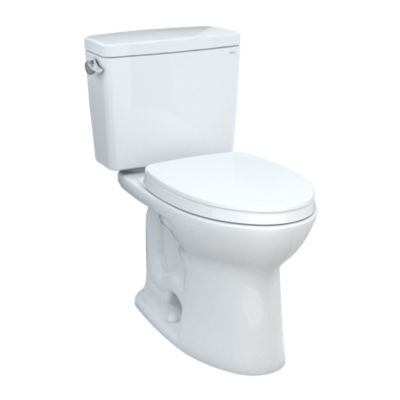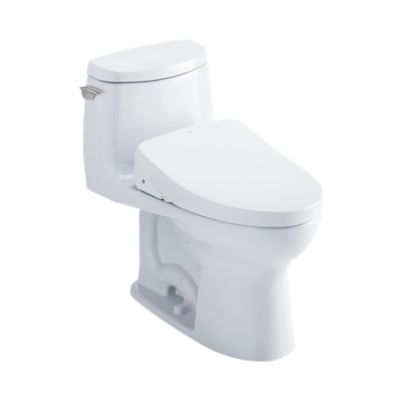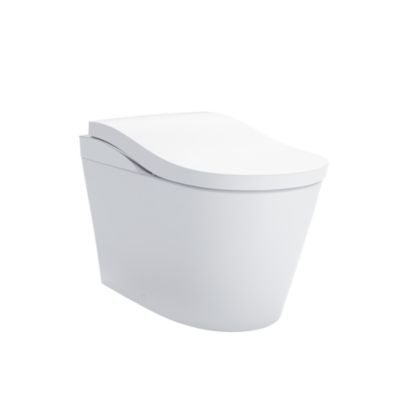TOTO USA: A Trailblazer in US Water-Saving Toilet Adoption
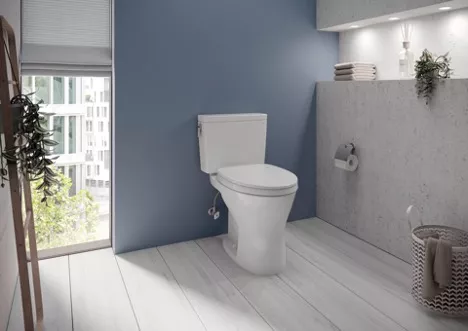 Drake 1.6 GPF and 0.8 GPF Dual Flush Toilet
Drake 1.6 GPF and 0.8 GPF Dual Flush Toilet
A History of TOTO’s High-Performance, 1.6 GPF Toilets in the American Toilet Industry
The evolution of the toilet, an unassuming but essential fixture in our homes and businesses, is an intriguing narrative that interweaves societal trends, cultural shifts, and technological progress. This narrative is particularly compelling in the United States, where the advent of the 1.6-gallon-per-flush (GPF) toilet, now considered a standard flush volume, symbolized a profound transformation in water conservation methods and mindset, impacting both residential and commercial sectors.
At the epicenter of this revolutionary shift was TOTO USA, an audacious pioneer in U.S. plumbing manufacturing. TOTO USA took the helm during the transition from high-flow toilets to the high-performance, low-flow toilets of the 1990s, steering the industry toward an era of enhanced water efficiency. TOTO’s bold solutions have shifted industry norms and recalibrated customer expectations, fostering a new understanding of what a toilet can and should be.
TOTO’s story and journey toward creating the 1.6 GPF toilet is one of foresight, innovation, and a deep-seated commitment to sustainable practices. It’s a story of a forward-thinking company leveraging its technological prowess to turn legislative challenges into opportunities for growth and industry leadership.
The Landscape: EPACT of 1992 and TOTO USA’s Vision for Water Conservation
In 1989, the growing concern for water conservation had been evident in the United States and globally for several decades, driven by population growth, increased agricultural demands, industrial expansion, and recurring drought conditions. States with arid climates, like California and Texas, had been at the forefront of grappling with water scarcity issues and had already implemented their water conservation measures. TOTO USA, a visionary in the plumbing industry, had recognized these emerging challenges well in advance. Drawing on TOTO’s rich legacy of water efficiency and technological innovation in Japan, TOTO USA was prepared to play a crucial role in addressing these issues in the United States.
Against this backdrop of rising environmental consciousness, the United States Congress passed the Energy Policy Act of 1992 (EPACT). This groundbreaking legislation marked a significant milestone in the history of American water conservation, reflecting a collective recognition of the urgent need for action. The EPACT of 1992 introduced stringent water usage standards for plumbing fixtures, including toilets, primarily focusing on reducing water consumption. One of the pivotal stipulations of the act was the reduction of toilet’s water consumption to 1.6 gallons per flush (GPF), replacing the previously prevalent models that used up to a hefty 3.5 GPF. This transition to 1.6 GPF toilets was a radical shift that aimed to conserve water resources on a massive national scale.
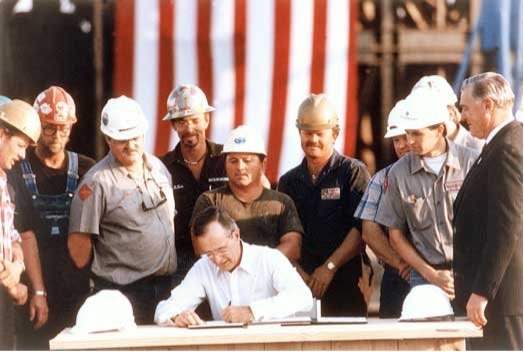 President George H. W. Bush signs the Energy Policy Act of 1992
President George H. W. Bush signs the Energy Policy Act of 1992It is worth noting that before the passage of the EPACT of 1992, several states in the U.S. had already begun implementing their own water conservation measures and efficiency standards for plumbing fixtures. Some of the states that were at the forefront of these efforts included:
- California: California had long been a leader in water conservation due to its semi-arid and arid climate, which often experiences drought. As early as the 1970s, California started implementing various water-saving measures, including restrictions on water usage, incentivizing water-efficient appliances, and promoting water-saving toilets.
- Texas: Like California, Texas also faces water scarcity issues, especially in certain regions. As early as the 1980s, Texas began encouraging water conservation practices, including water-efficient toilets and other fixtures.
These states, along with others, recognized the importance of water conservation well before the passage of the EPACT of 1992. Their proactive approach to implementing water-saving measures and promoting water-efficient plumbing fixtures helped pave the way for the nationwide standards established by the federal legislation. The EPACT of 1992 provided a unified approach to water conservation, ensuring that all states adhered to the same water usage standards for plumbing fixtures, including the requirement for 1.6 GPF toilets.
For TOTO, the EPACT of 1992 was not seen as a deterrent but as an exciting opportunity. The company had long embraced a strong commitment to sustainability and environmental stewardship, evident in its track record of water-efficient innovations. With its rich heritage and expertise in Japan, TOTO was well-positioned to enter the American market and align with the new water conservation standards. The introduction of the EPACT of 1992 set the stage for TOTO to showcase its dedication to sustainability, leveraging its technological know-how to redefine industry norms and drive transformative change in the plumbing sector.
By embracing the challenge presented by the EPACT of 1992, TOTO demonstrated a clear vision for the future of water-efficient toilets in the United States. The company’s commitment to environmental stewardship and its formidable reputation for technological innovation positioned TOTO as a key player in revolutionizing the American plumbing industry, and this pivotal moment laid the foundation for TOTO USA, its new U.S. subsidiary, to make a lasting impact and become a trailblazer on the journey toward water conservation and sustainability in the U.S.
From Japan to America: TOTO’s Entry Into the US Market With Water-Saving Toilets
The American bathroom scenario before the 1990s was dominated by high-flow toilets, most of which consumed around 5-7 gallons per flush. With its expertise in crafting high-performing, low-flow toilets, TOTO saw this as an opportunity to shift American attitudes toward toilets. Water-scarce regions such as California and Texas were especially receptive to this shift. The demand for water-saving toilets had been gaining momentum since the early 1980s, but the market was sorely lacking in reliable solutions. The stage was set for a change-maker like the new TOTO USA, armed with cutting-edge technology and a profound commitment to water conservation, to make a profound impact.
The Innovation Challenge: TOTO’s Technological Advancements
 C830 from the Romancia Series 1986˜1993
C830 from the Romancia Series 1986˜1993
The design of a 1.6 GPF toilet, which would meet the U.S. legislative requirements and outperform traditional high-flow models, was formidable. TOTO, however, was undeterred by the complexity of the task. The company poured considerable resources into research and development to engineer a product that would flawlessly balance water conservation with efficient waste disposal. TOTO found inspiration in its backyard — the Siphon toilet from the Romancia series, a popular product line in Japan. Embarking on a journey of relentless innovation, TOTO reimagined every aspect of the toilet, leading to revolutionary breakthroughs in bowl and trapway designs, flush valve systems, and flushing mechanisms — each iteration aimed at a singular goal — minimizing water usage without compromising performance.
The Epitome of Excellence: Model CW703
After tireless efforts, the pinnacle of TOTO’s innovation came to life in 1988 with the introduction of the CW703 model. This toilet was a true engineering marvel that embodied TOTO’s commitment to water conservation without sacrificing efficiency. It wasn’t just the reduction of water usage to 1.6 GPF that set the CW703 apart; it was its meticulous design and relentless testing that ensured its superior performance.
Creating the CW703 model involved more than just adhering to the new 1.6 GPF standard — it was about excelling within this requirement. The development process began with TOTO’s engineers meticulously designing and optimizing every aspect of the toilet’s performance. The bowl and trapway designs, flush valve systems, and flushing mechanisms were painstakingly reimagined and refined, ensuring each component functioned optimally while minimizing water usage.
Once the design phase was completed, the CW703 model underwent rigorous tests. It was essential for TOTO that the CW703 not only met the EPACT of 1992 regulations but also outperformed conventional high-flow toilets. To achieve this, TOTO subjected the CW703 model to various performance tests, simulating different real-world scenarios to ensure that the toilet could handle a wide range of waste loads effectively and efficiently.
The CW703 was tested for its flush performance using a variety of mediums — the tests aimed to replicate different types of human waste, from spherical balls to miso paste, which most closely resembles human waste. The toilet was also tested for its resistance to clogging and its ability to clear waste in a single flush. These tests were repeated countless times; each time, TOTO engineers analyzed the results and refined the design as needed.
The stringent testing process didn’t stop there. TOTO also tested the CW703 model for durability. Components were subjected to extensive lifecycle tests to ensure they could withstand the wear and tear of long-term use. The toilet’s structural integrity was tested by applying heavy loads to various parts, simulating years of usage to ensure the CW703 could stand the test of time.
After countless iterations and refinements, the CW703 model was finally ready for the market. But the testing didn’t stop there. TOTO closely monitored customer feedback and real-world performance data, prepared to make any necessary tweaks to enhance the CW703’s performance further.
The U.S. launch of the CW703 marked a significant turning point for the young company, TOTO USA. This model demonstrated that water-saving toilets could deliver high performance that matched or exceeded their high-flow counterparts. This was a testament to TOTO’s unwavering commitment to sustainability, innovation, and excellence, a commitment that continues to drive the company forward today.
 1.6 GPF TOTO Toilets CW703 and CW704
1.6 GPF TOTO Toilets CW703 and CW704
In 1999, a tongue-in-cheek Washington Post article, “Tempest in a Toilet,” highlighted the challenges manufacturers faced to create toilets that met the government mandate of 1.6 GPF and the flushing test. At the time, only five toilets passed a side-by-side flushing test conducted by Contractors 2000 (now known as Nexstar) in St. Paul, Minnesota. One was, of course, TOTO’s next-generation toilet, the CST704.
Lasting Legacy: TOTO USA’s Impact on Plumbing Regulations
TOTO USA’s introduction of high-performance 1.6 GPF toilets brought about a seismic shift in the American plumbing industry. The superior performance of TOTO’s advanced technology proved that water conservation and efficient waste removal could coexist, dispelling any doubts about the effectiveness of low-flow toilets. As TOTO USA upheld its promise of uncompromising performance and sustainability, consumer trust in the brand grew, and TOTO USA’s reputation as an innovation trailblazer in the plumbing industry was cemented.
In 1999, TOTO USA played a pivotal role in the ongoing discussions surrounding water efficiency and plumbing regulations by presenting before a congressional hearing in opposition to the enactment of H.R. 623.
This proposed legislation sought to roll back some of the water conservation standards established by the Energy Policy Act of 1992 (EPACT of 1992), including the requirement for 1.6 GPF toilets. As a leading innovator in the industry, TOTO USA firmly believed that water-saving measures were crucial for environmental sustainability and responsible water usage. The company passionately argued in favor of retaining the 1.6 GPF standard, citing the success of their advanced technology and the positive impact of water-efficient toilets on water conservation efforts. Through their compelling testimony, TOTO USA emphasized the importance of continuing to pursue more efficient and sustainable plumbing solutions, despite resistance from some quarters of the industry. TOTO’s participation in the congressional hearing exemplified its unwavering commitment to driving positive change and redefining industry norms for the greater good.
The role of TOTO USA in reshaping the American plumbing industry is a testament to the power of innovation and a clear vision for sustainability. TOTO USA has played a defining role in shaping the industry’s future by continually pushing the boundaries of technology and water efficiency. As we grapple with pressing environmental challenges, TOTO USA’s legacy continues to inspire those of us within the industry. And our story is a potent reminder that every drop of water saved is a significant step towards a more sustainable future — one flush at a time.
